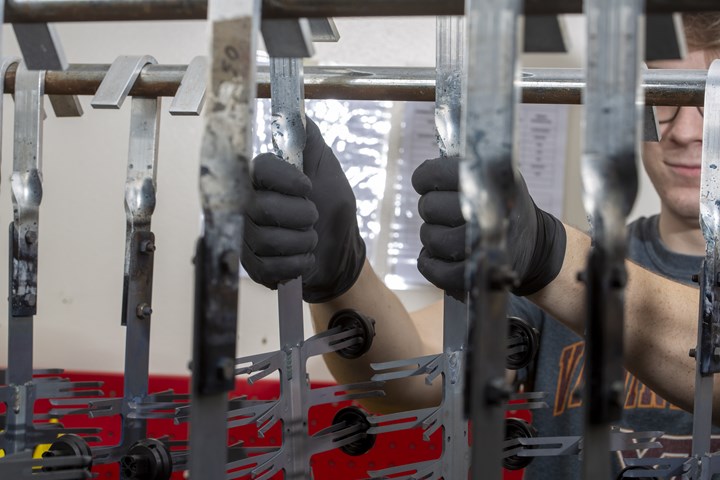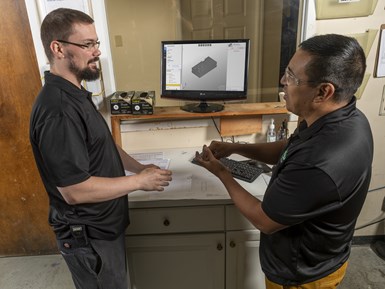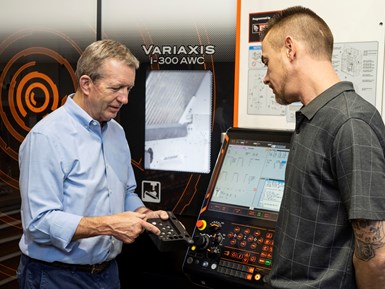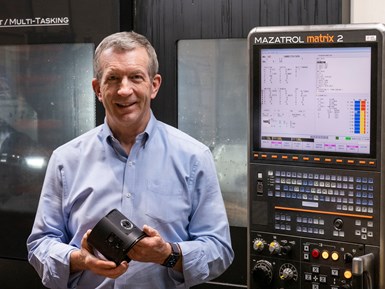Share

Global Metal Finishing (GMF) exemplifies the two most important basics of success for a metal finishing company: reliance on sound and exact science and the attention of a skilled and dedicated workforce. Here, a technician makes final adjustments to parts arranged on racks for finishing by applying his experience, precise process parameters and well-maintained equipment for best results. Photo Credit: Global Metal Finishing
“We want the job shop to treat us as if we are one of their internal departments.”
“We want the finishing shop to feel like it’s one of our internal departments.”
The first statement above is a close paraphrase of Tamea Franco, president and CEO of Global Metal Finishing (GMF), a supplier of diversified metal finishing processes in Roanoke, Virginia. Likewise, the second statement is a close paraphrase of comments from Grady Cope, president and CEO of Reata Engineering, a machining job shop and contract manufacturer in Englewood, Colorado. Although Franco and Cope have not met in person and neither company has done business with the other, these two business leaders have much in common.
Both represent a notable achievement in bringing finishing suppliers and machining job shops together in a new and mutually beneficial relationship. Their comments above characterize this relationship perfectly. Both parties must communicate effectively, cooperate evenhandedly and regard one another as respectful partners. In short, the two parties must be as well integrated as two internal departments in one company.
Job shop and finisher need one another
In addition to precise machining, many workpieces produced by job shops require plating, anodizing, painting or other finishing process before the shipping the parts to the customer. Typically, however, machining job shops are not equipped to provide finishing processes. These processes usually require dedicated equipment and know-how to be completed to exacting specifications. This is the domain of finishing companies that specialize in one or more of these processes.
Therefore, the job shop and the finisher must work together closely so that the end customer is satisfied. Satisfaction, in this case, almost always boils down to receiving parts on time, with the proper finish and accuracy to the specified dimensions. Of course, both the finishing shop and the job shop should be rewarded with profitable revenue for their work. Unfortunately, a gap often develops between the job shop and the finisher when they fail to mesh their operations.
GMF and Reata are closing or avoiding this gap by adopting software designed to streamline the quoting process. That a new generation of quoting software can act as a bonding agent should not be surprising: the quoting process not only sets the proposed terms for a mutually agreeable business transaction, but also it invites the parties to establish a mutually agreeable business relationship. Moreover, when the finisher and the job shop are in sync, the job shop’s finished quote to a prospective customer is likely to be more accurate, timely and successful in winning the order.

In this example of a sample part shown in the Paperless Viewer as a finisher would see it, data necessary for a finishing quote is readily available. The inset magnifies a key feature of the viewer – the chat panel that captures exchanges between team members as a record of their input. Photo Credit: Paperless Parts
The quoting software GMF and Reata implemented is from Paperless Parts (Boston, Mass.). This software is based on fundamental insights into the quoting process, including the need for timely sharing of critical information. These insights naturally lead to a better understanding of what the finishing company and the job shop can do for one another, ultimately in service to the end customer. GMF and Reata exemplify why this is a win-win-win scenario, but from different perspectives.
A stronger partner

The viewer enables GMF employees to consolidate their thinking when a quote is prepared. Because the 3D model includes calculations of part properties essential to finishing processes, employees can give more attention to optimizing these processes. Photo Credit: Global Metal Finishing
Global Metal Finishing is at once an exceptional metal finishing company and a very typical one. GMF specializes in aluminum anodizing and precision hard coating, as well as passivation, chromate treating and custom services. Franco leads her company with an exceptional combination of passion for the industry, entrepreneurial spirit and creative energy (drawn from her years serving the art community’s needs for dyes to color metal jewelry and artwork components).
“I have 33 very talented and dedicated people as employees of GMF, and I need this talent and dedication for the precision and quality I insist we provide to our customers,” Franco says, adding that her workforce “drives itself to be the best.”
Yet GMF faces many of the same challenges shared by other finishing companies — especially those related to dealing with metalworking job shops that contract for finishing services.
Franco says that before moving to its new quoting system, the biggest problem had been hindrances to communicating effectively with prospective customers, mainly during the quoting process, which is chiefly how GMF and job shops interact. As she points out, a finishing shop needs specific information to respond to a job shop’s RFQ, and this information is often incomplete or difficult to determine.
“We need data, hard data,” she says. “Anodizing, hard coating and other processes have to be approached scientifically. The chemistry and the electrical engineering in anodizing, for example, involve many precisely controlled variables, all of which are essential to success of the process.” However, when hard data from the job shop is not forthcoming, GMF’s VP of operations and sales Ben Lawhorn and ISO and QC inspection manager David Fralin frequently had to make their best guesses, resulting in inconsistent pricing and uncertain scheduling commitments.
As a result, Franco says, GMF had not been able to function fully as a trusted partner and revenue source to job shops. This is also a matter of good communication. “Give me the right information and I can help a shop more effectively and increase its profits,” she says.
Better communication would also overcome the misunderstandings that many job shops have of finishing shops. “This is a problem not only for GMF, but also for our industry,” Franco insists. From experience, she believes that many machining job shops do not understand or value the work finishing companies do.
“Finishing processes are as complex and demanding as any machining process,” she notes. “We face the same concerns about setup, process parameters and productivity as the machine shop.” In fact, she contends that the finisher has other concerns that may not be familiar to the job shop, such as dealing with tasks that are not well-suited for automation. For example, racking (the process of placing parts on the hooks attached to the metal framework immersed in a tank) has to be done manually, despite efforts to automate it over the years. She says that at least 10 shop people touch every job that passes through.
According to Franco, GMF’s move to the Paperless Parts quoting system is resolving these problems, especially if the job shop also uses this software. Franco and her staff saw ads for the Paperless Parts quoting system and attended one of the software developer’s webinars early in 2020. GMF’s COO, Al Vasilauskas, listened in and the system’s capabilities struck a nerve. “That’s what we need,” he said. The software was in place less than a month later.
Franco says the new quoting software gives her shop three major benefits. One, it enables her quoting specialists to quickly get the information and hard data they need. With the Paperless Parts system, the 3D model the job shop uploads has part volume, surface area and weight already calculated. Two, the system eases the process of asking questions to the job shop issuing the RFQ, with both parties capturing this exchange in their respective job folders. Although the job shop can annotate the model with details relevant to finishing, GMF frequently sees options to improve or optimize finishing processes. Running these suggestions by job shops for approval has resulted in process efficiencies, cost savings and prompter scheduling that may have been overlooked otherwise. Three, GMF can help issue the quote quickly using the software’s streamlined quoting templates. According to Franco, quotes return in minutes rather than hours, with improved consistency and accuracy.
Franco also reports an unexpected but welcome benefit from streamlined quoting. Ashlynn Taylor in GMF’s dry-to-pack department noticed that requests for a certain rack number seemed to be trending upward. Because Paperless Parts’ software records quotes in a searchable database, Taylor could confirm this trend by checking the archived quoting activity. She urged the processing department to order more of that style right away, thus averting a potential bottleneck in the racking process.
Franco makes one last point about the benefits of the quoting software that is especially relevant in today’s environment of growing cybersecurity threats: “Paperless Parts software complies with Department of Defense requirements for data security. When we use this system, I know that critical data and intellectual property is safe, whether it’s our data or the customer’s data. All of us are protected.”
And that brings us to the job shop’s side of the story.
Giving the finisher its due

At Reata Engineering, Grady Cope (left) shows David Hartfelder an aluminum workpiece with black anodizing to verify the absence of visible rack marks from the finishing process. Reata worked with the finisher to develop special masking and racking procedures, along with customized rack hardware, to avoid these marks. In the background is the Mazak Variaxis five-axis machining center on which the part was produced. Photo Credit: Reata Engineering
“The biggest challenge for a job shop like ours in preparing a quote is getting the right information from the right places at the right time, including cost figures and delivery dates from a finishing subcontractor,” says Cope. His shop, Reata Engineering, has customers in a range of industries — but are largely seeking high-precision aluminum work pieces for aerospace and medical products. “Our sweet spot is a part that fits inside a shoebox and can be produced on multitasking, multi-axis machining centers,” Cope explains. “We have Mazak Integrex machines, a 40-pallet Mazak Variaxis five-axis machining center and several Mazak horizontals with Palletech integration for lights-out or lightly-attended operation.” The company has 45 employees.
In addition to investing heavily in highly efficient, productive machining technology, Cope’s shop aggressively invests in software for CNC programming, cutting tool management, shop scheduling and machine monitoring. Without this software support, he says, it would be difficult for the shop to unlock the full potential of its automated machining systems.
However, he says there was one weak link in his shop’s processes: quoting was a bottleneck and somewhat unreliable. “We need to keep these machines busy 24/7 with jobs that we know how to make money on, at least think we know how to make money on,” Cope says. He says the multitasking machines are flexible and capable, so complex, high-precision work is where they shine. The quoting and estimating people at Reata have the flexibility and capability to match, but quoting also involves creativity and resourcefulness. It does not occur with a predictable reliability of programmable operations. “It’s really as much art as science,” says David Hartfelder, Reata’s chief quoting and estimating person. “Although we have had only a few misses, the process was still more time-consuming than we would like.”
Not surprisingly, Cope and his staff took immediate interest in news about the quoting software from Paperless Parts. He and several of his shop leads listened to the webinar sponsored by the software developer, which convinced them it was the missing link in their software-based shop management systems. Reata installed the new quoting system in full by September 2020.

Although Reata relies on its multitasking machining centers – such as this Mazak Integrex i400 machining center – to machine workpieces completely in one setup, the shop relies on finishing subcontractors for anodizing parts to customer specifications. Here, Grady Cope holds a typical close-tolerance aluminum part that requires precise masking before the application of an anodized finish. Photo Credit: Reata Engineering
Cope and Hartfelder agree that the system delivered what they expected. “The software applies an intelligent pricing engine that interprets a CAD model of the workpiece according to cost variables customized to reflect our shop’s capabilities and constraints,” Hartfelder says. “Results are automatically formatted to produce an attractive, template-based presentation that can be emailed as a timely response to an RFQ.”
One system add-on Hartfelder says is especially useful is Collaboration, a set of web-based communication tools that interface with the Paperless Parts quoting system for transmitting queries to inform shop personnel about the best way to machine a part. “We capture the exchanges digitally and make them a permanent part of the data packet associated with each job quote,” he says.
He also says this system not only streamlined and automated the quoting process, but also changed the shop’s philosophy about quoting in general. “The artificial intelligence features of the software, which are customized to fit our shop’s profile, do the calculations we need to get pricing figures and delivery dates that are consistent and close enough to ensure that if we get the job, it will be profitable,” Hartfelder says. “We could quickly identify the jobs that weren’t likely to be right for us, so we stopped wasting time on full-blown quotes for these parts. We also realized that issuing close-enough quotes and winning only 30% of them would keep our machines adequately busy.”
The other big change was how the software transformed the way Reata interacted with its finishing suppliers. The same features that literally got key sources of process information for quoting on the same (digital) page within Reata, also helped the company’s finishing supplier. Reata can now upload and securely share a 3D model of a workpiece with the finisher, who can access it with a free Paperless Viewer account. As noted above, the uploaded model instantly provides the information the finisher needs to know, such as surface area, volume and weight. Equally valuable, Reata can annotate the model to mark holes that need plugging, features that need masking and its preferred places for racking the parts during finishing.
Cope says this information enables the finisher to ask questions or suggest options in a secure chat that is captured automatically as part of the quote file. In many cases, the finisher can return all of the definitive information necessary for Reata to issue a completed quote without the need for back and forth exchanges.
“In our experience, being able to reply to an RFQ within 24 hours greatly increases our chances of winning the job. Getting an accurate quote from the finisher within hours or even minutes contributes immensely to hitting that goal,” Hartfelder says. He also adds that if Reata does win the job, the finisher’s part of fulfilling the work is likely to proceed without a hitch as well.
Coming together
This brings us to a convergence of the finisher and job shop as partners able to cooperate as closely as operations under one roof. Franco and Cope see this development well within reach, and see it helping usher in a new era in U.S. manufacturing.
On the finisher’s side, Franco’s experiences with enhanced job shop communication facilitated by the quoting software are a measure of this progress. “Hard coating is one of our four main specialties,” she explains. “One job shop requested hard coating for a large piece of machined aluminum, but the holes indicated as allowable for racking would not give us even distribution of electrical current, which is needed for the best plating results. We wanted at least four contact points. Because we could examine the 3D model of the part in the Paperless Parts viewer, the best places for the four preferred electrical contact points were easy to identify. Our engineers worked with the shop’s engineers to be sure our racking suggestion was acceptable. With their feedback, we arranged a racking pattern that minimized racking marks yet yielded a consistent and complete coating.”
Better communication at the quoting level also helps avoid unexpected delays by syncing job schedules between finishers and job shops. “If the machine shop runs late on a job, they often expect the metal finisher to make up that time by expediting the order,” Franco says. “Because the new quoting software creates a direct line of communication, we can get progress updates that enable us to anticipate delays and adjust our scheduling priorities.” Franco says this system also works the other way: giving the job shop clear targets for her shop’s scheduling requirements upfront in the quote can head off these conflicts, allowing both sides to avoid unwelcome surprises that can disappoint the end customer.
From the job shop’s point of view, Cope recounts similar experiences pointing to a new level of cooperation and partnership. “It’s not unusual for our CNC machinists to ask for a change in fixture design or a pocketing routine and have the CNC programming department provide new code to the shop floor right away,” he says. “We could be just as responsive when a finisher recently asked us to make and install several aluminum fasteners and washers on an unusually complex medical part so a good electrical connection could be achieved for perfect anodizing. All the information we needed to do this was available in the annotated model returned by the finisher.” Cope reports that complying with the request was handled with the same matter-of-course effort as a shopfloor change request.
In another case, a finisher requested that Reata provide a tab with a racking hole in the critical initial part machining. The part required additional machining after plating anyway, so removing this tab at this point was inconsequential, yet having the added hole greatly improved the ease and quality of the plating process. “The chat feature in Paperless Parts enabled our staff to review and discuss this change and confirm it with visualization,” Cope says. “The effort was fast and flawless.”
Interfacing the quoting system with existing ERP systems has become a priority for GMF and Reata. Both companies rely on ERP for shop scheduling.
Cope reports that an interface to Reata’s ERP system customized by Paperless Parts has reduced manual entry of job data when a quote is accepted. He also sees this integration becoming a digital platform for alerting the shop floor to scheduling updates.
As a finisher, GMF uses an ERP system primarily for issuing travelers to facilitate workflow. Franco notes that most ERP systems are tailored for scheduling machining workstations, so they are less effective in the finisher’s environment. Even so, she sees the networking capability of the quoting system bridging the gap as GMF reevaluates its approach to scheduling.
Creating a better image
Can a quoting system change the image of an industry? Franco says yes. Lawhorn concurs, saying, “This software is what the finishing industry needs to promote its value as well as create closer alignment and partnership with contract manufacturers. The finisher and the job shop can learn from and help one another. Respect and understanding improve significantly, especially when both parties are using the same quoting software.”
At Reata, Cope agrees with this assessment and adds that the quoting software and its centralized, integrated approach to capturing critical process data have taken his shop closer to the data-driven, fully digital mode of manufacturing envisioned in the Industry 4.0 concept. He notes another benefit for recruiting purposes, saying that “digitalization is appealing to secondary and post-secondary students attracted to careers in manufacturing. Because Reata is very active interfacing with schools in our region, we can detect how the emerging image of manufacturing as an industry with an exciting, vibrant future is influencing their interest.”
As a final note, both Franco and Cope believe that strengthening the image and efficiency of America’s contract manufacturers and finishing companies boosts U.S. manufacturing at a time when its global competitiveness is at a pivot point.
Related Content
AI Tool Optimizes, Automates Powder Coating
New “digital Blueprint” technology fine-tunes every aspect of a powder coating system. The platform promises at least 10% powder savings, a return on investment of a few days and an increase in uptime.
Read MoreUnlock Unparallelled Reliability
By prioritizing reliability in every aspect of its service offerings Dynapower ensures your equipment operates at peak performance levels consistently. With a steadfast focus on reliability, Dynapower’s field service, preventative maintenance and spare parts solutions ensure uninterrupted operations, minimizing scrap and maximizing uptime.
Read MoreERP Provider Demonstrates Streamlined Installation
Steelhead Technologies claims 36-hour ERP deployment sets new industry standard.
Read MoreAR Iron Powder Coating Division Achieves AAMA Certification
AR Iron's powder coating division has achieved AAMA 2604 and AAMA 2605 certification.
Read More
















